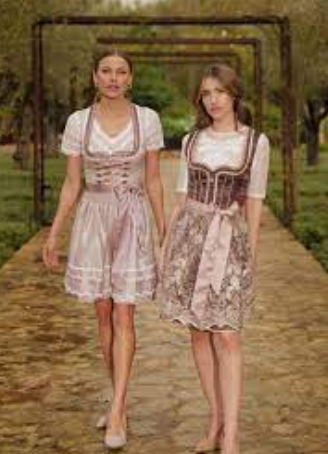In the heart of Europe lies a garment that encapsulates tradition, beauty, and cultural heritage—the dirndl. With its vibrant colors, intricate details, and timeless elegance, the dirndl dress has become a symbol of Alpine fashion and an embodiment of regional pride. This blog post delves into the fascinating history of dirndls, tracing their origins, exploring their significance, and celebrating their enduring appeal. Join us on a journey through time as we unravel the colorful tapestry that is the dirndl.
Origins and Evolution
Table of Contents
The Origins of the Dirndl:
The dirndl’s origins can be traced back to the early 18th century in the Alpine regions of Germany, Austria, Switzerland, and South Tyrol. Initially worn by rural women as a practical and modest outfit for daily activities, the dirndl gradually transformed into a symbol of national identity and cultural pride.
A Fashion Evolution:
Over time, the dirndl evolved to incorporate various influences, reflecting changes in fashion, social status, and regional customs. In the 19th century, it experienced a resurgence as a fashionable attire, thanks to the Romantic Movement, which idealized rural life and traditional costumes. Empresses and nobility alike embraced the dirndl, cementing its status as a fashionable garment.
The Elements of a Dirndl:
A dirndl consists of several key elements. The bodice, known as the “Mieder,” is a fitted top that accentuates the waist and bust. The blouse, typically made of white cotton or linen, adds a touch of femininity. The skirt, often full and pleated, reaches below the knee and is adorned with vibrant patterns, floral motifs, or traditional embroidery. Completing the ensemble is the apron, which is tied around the waist and adds a pop of color and style.
Symbolism and Cultural Significance
Regional Diversity and Symbolism:
The dirndl is not just a fashion statement; it carries deep cultural symbolism and regional diversity. Each region has its own unique style, color palette, and embroidery patterns, representing its distinct heritage. For example, the Bavarian dirndl is characterized by a tightly fitted bodice and a full skirt, while the Tyrolean dirndl features a more structured silhouette with elaborate embroidery.
Rites of Passage and Special Occasions:
Dirndls play a significant role in traditional ceremonies and celebrations. They are commonly worn during Oktoberfest, the world-famous Bavarian beer festival, where women proudly showcase their dirndls, often paired with accessories such as traditional hats and jewelry. Dirndls are also a staple at weddings, where the bride and her bridesmaids often wear variations of this iconic garment, adding to the festive atmosphere.
Contemporary Resurgence and Global Appeal
Dirndls Today:
In recent years, dirndls have experienced a remarkable resurgence in popularity. Modern designers have reimagined this classic attire, incorporating contemporary elements and materials while staying true to its cultural roots. Today, dirndls are not limited to special occasions but have become a stylish choice for everyday wear and even high fashion runways.
Global Influence:
The appeal of dirndls has transcended borders, captivating people from around the world. Tourists and fashion enthusiasts flock to Alpine regions to acquire authentic dirndls, appreciating the craftsmanship and attention to detail. The dirndl has also inspired international designers who incorporate its elements into their collections, paying homage to its timeless charm.
Wrapping it Up
From its humble beginnings as a practical garment for rural women to its current status as a fashion icon, the dirndl has traversed the realms of history, culture, and style. Its vibrant colors and intricate designs continue to captivate hearts, making it a beloved symbol of tradition and femininity. The dirndl’s evolution reflects the changing times while preserving its cultural significance. Whether worn during festive celebrations, traditional ceremonies, or as a fashion statement, the dirndl remains a powerful representation of regional diversity and heritage.
So why not immerse yourself in the world of dirndls? Explore the different styles and patterns, discover the regional variations, and embrace the vibrant spirit they embody. Whether you choose a classic design or a modern interpretation, wearing a dirndl is not just about fashion—it is a way to honor history and celebrate the beauty of cultural heritage. As the dirndl continues to weave its magic across the globe, let us remember its humble beginnings and the journey it has undertaken. From its rural origins to its global influence, the dirndl remains an emblem of timeless elegance and a testament to the enduring power of traditions.
So, next time you catch a glimpse of a dirndl, take a moment to appreciate the intricate craftsmanship, the stories it holds, and the vibrant culture it represents. For in this colorful tale of dirndls, we find not only a piece of clothing but a piece of history, woven with love, pride, and a celebration of the human spirit.
Read article more piticstyle


